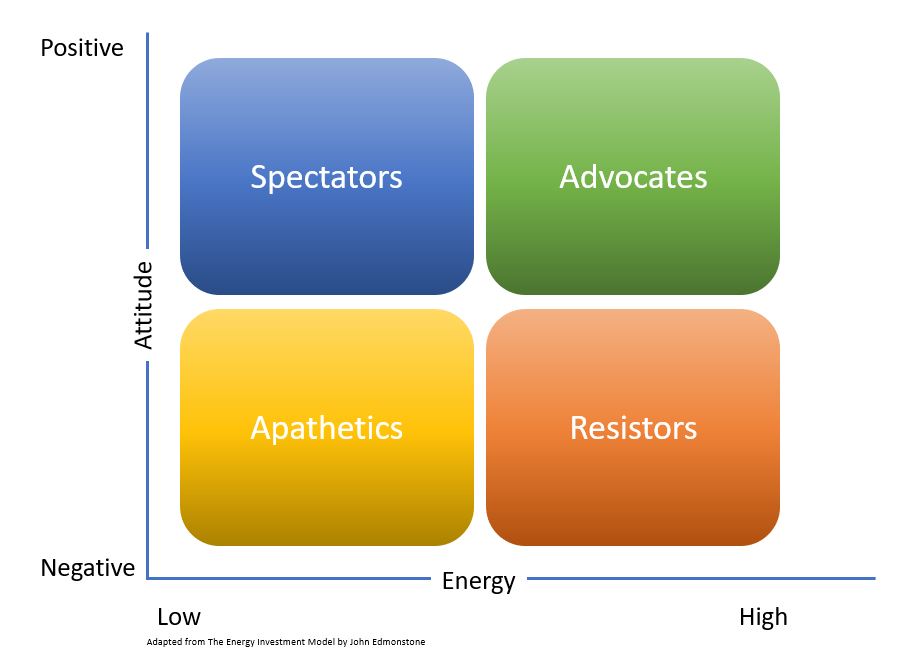Ok so let’s talk about the elephant in the room.
No team is perfect and from time to time, one of the team members are just not willing to play. They drag their feet, don’t live up to commitments and sap the energy of the group.
Ok so you’ve done the team building day, you may have even done some training along with the Five Behaviours of a Cohesive Team assessment, but there’s still something wrong.
Despite the slight shift in the dial, the team is still not collaborating as well as it could do. Still not fully utilising the strengths individuals bring to the collective team effort. Conversations remain polite, but often disengaged and worst of all, nobody is prepared to call out unhelpful or downright disruptive behaviour.
Everyone is waiting for the team leader to solve the ‘problem’ of the team member who’s not pulling their weight.
But wait. Maybe the whole thing needs some re-evaluation.
Team engagement is not a static state. Different people bring different states of mind or attitudes at different times, to different issues. Likewise, people will bring different levels of energy or commitment to different tasks and things that are happening in the team.
Their attitude and energy combine to produce different behaviours that impact, positively or negatively, on people’s perceptions of their teammates and whether or not they are team players.
Rather than discounting the perpetual offender as a ‘lost cause’ it may be worthwhile re-considering their attitude and how their energy plays out.
A useful model is one based on John Edmonstone’s Energy Investment model that was originally focused on action-learning sets, but can help us when thinking about team members. The two dimensions – attitude and energy – combine to enable us to better understand four different types of behaviour that might exist in a team.
By applying some emotional intelligence – particularly empathy and social skills – we can start to appreciate where they are coming from and perhaps nudge them into contributing a more committed approach to the team effort.
Team members with seemingly low energy levels and a far from positive attitude to things that are happening with the team can be labelled Apathetics.
They seem overwhelmed at work, constantly retreating into their comfort zone and shying away from new initiatives. They hardly engage in team meetings, generally avoiding confronting issues. Their whole demeanour says, “ I just can’t be bothered”.
Spectators, on the other hand, seem to express a far more positive attitude to what is happening and may actually want to contribute. But while acknowledging good ideas positively, they seem to lack confidence and are reluctant to take the initiative themselves. They tend to be risk averse and much prefer to watch from the sidelines until things get back to ‘normal’.
Resistors, have a lot of energy and are usually vocal in a team. Their attitude is negative and they seem to be unaware of the impact of their negativity on others. They are the ones who have the 1001 reasons why a new idea won’t work. Their vocal criticism saps the teams energy through incessant fault finding.
Advocates, by contrast, have a more optimistic and positive attitude and are energised by challenge and opportunity. They are willing to come out of their comfort zone and try new things. They find humour in ambiguous situations and are open to suggestions from other team members.
The question for team leaders is how to affect small noticeable changes in attitude and energy in Apathetics, Spectators and Resistors that moves them more towards the Advocates camp?
Team leaders need to both empathise with these different starting points, as well as trying to influence their approach. Here is where understanding and compassionate leadership can make a big difference. Rather than becoming frustrated with the presenting behaviour, more human conversations can help to start to tip the balance.
Here a more coaching approach from the team leader in their interactions with the four behaviour types can make a difference to the team as a whole.
Apathetics were most likely to have been driven to that camp through past experiences, particularly where previous effort and commitment were passed over without acknowledgement. It’s likely that their previous ideas have either been rejected out of hand or even ridiculed, their efforts devalued or undermined. Their confidence bashed, they have retreated into a ‘they don’t care, so I don’t care’ approach.
Apathetics need empathy and understanding in dealing with their frustrations and lack of confidence. Encouragement on small manageable challenges, that are recognised and psychologically rewarded will rebuild their confidence. Thought provoking questions can help. What feelings does your success in this team depend on? What could you do to make a start? What’s the worst thing that could happen if you tried . . (something new)?
Spectators need support and encouragement to get off the fence. Because they are risk averse, tasks that reinforce their confidence and reduce their perception of risk make a big difference. Slowly ratcheting up the challenge while providing a safe environment to raise concerns enables them to view what’s possible more optimistically.
Questions for them include: Who do you consider a role model in this team? Which of their behaviours do you think you could emulate? If you knew there were no negative consequences, what’s stopping you from having a go? What one personal development area would you like to focus on this . . (month, quarter, year)?
Resistors, while challenging, also need empathy and compassion. A lot of their behaviour comes from feelings of not being listened to or ignored, especially when they have a valid point. Their competence and experience drives their energy, but they often fail to deliver their objections in ways that don’t make them sound like a cynic. Because they are usually bright and have experience, it is important to engage them in talking about an alternative view of things.
Solicit answers to questions that make them think deeply and feel heard. What factors lead you to that conclusion? Could there be anything that we’ve missed or ignored? We need to make this happen as a team, what would be your recommendations? How can we avoid any pitfalls?
Although Advocates demonstrate both positive attitudes and energy in the team, they too can benefit from being challenged in their thinking.
Questions such as: Are you bringing the rest of the team along with you? How sensitive are you to other team members thoughts and concerns? How could we utilise your commitment to bring along others in the team who don’t feel as committed?
In all cases, reinforcing feedback and encouragement of any signal of positive behaviour is essential. Team leaders can’t assume that all team members will have the same level of energy and positive attitudes all of the time. Engagement and commitment come from any number of sources and varies depending on the circumstances, but any elephant in the room cannot be left unaddressed. Everyone in the team will know there’s an elephant in the room and will be expecting the team leader to do something about it.
If you want to learn how to build a more human and compassionate workplace and amplify team engagement and performance, then get in touch. We have a range of solutions that produce practical results.

